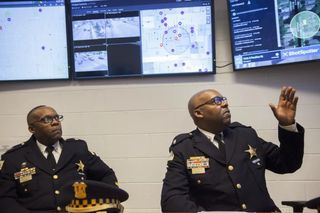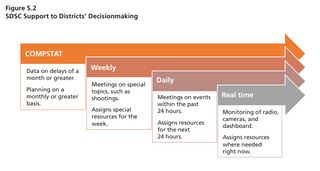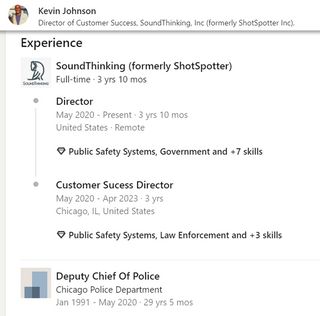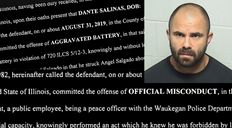Former CPD deputy chief on the ShotSpotter sales team shilling lies about the faulty tech
Kevin Johnson, like other former police officers on the customer success team, is entitled to a police pension in addition to any salary he collects from SoundThinking.
by Jinx Press Collective Feb 8, 2024
Share this article:

A retired Chicago Police chief who was instrumental in piloting the technology’s widespread invasion of Chicago’s neighborhoods is now traveling the country on the company’s dime to promote the gunshot detection system—and touting falsehoods about ShotSpotter’s effects on gun violence in his sales pitch.
Last month, Kevin Johnson pitched ShotSpotter (recently rebranded SoundThinking) to Carbondale, a small city in southern Illinois where 42 shootings with victims occurred between January 2020 and July 2022.
WSIL News 3 reported Johnson told the Carbondale city council “technology like ShotSpotter was used to reduce gun violence in some of the highest crime areas” in Chicago.
Jinx Press can find no research or evidence to corroborate Johnson’s ongoing claims that ShotSpotter produced any long-term effects of reduced gun violence in Chicago.
Johnson Leads ShotSpotter Chicago Launch and Claims Immediate Results

Before being promoted to Deputy Chief of the Education and Training Division, Kevin Johnson worked as a commander in the 11th (Harrison) District. Areas of the West Side launched a pilot of updated ShotSpotter technology in January 2017.
ShotSpotter was one of many tech products acquired for CPD’s new Strategic Decision Support Centers (SDSCs) in the 11th and 7th (Englewood/South Side) Districts.
The University of Chicago Crime Lab employed “embedded analysts” at the SDSCs during the implementation phase. The Crime Lab analysts guided sworn and civilian CPD staff in using new surveillance technology like ShotSpotter, understanding predictive policing programs like HunchLab (bought by ShotSpotter in 2018), and producing crime reports.
In March 2017, Johnson told the Chicago Sun-Times that the new police tech and surveillance tools used in the SDSC—including ShotSpotter—were responsible for a reported 45% reduction of shootings in his district.
These bold claims made by CPD and University of Chicago Crime Lab were based on merely two months of data analysis. They have not been replicated in any long-term research. No studies performed nationwide have ever demonstrated a causal link between ShotSpotter installation and reductions in gun violence.
By October 2017, SDSCs were established and ShotSpotter sensors were installed in six police districts on the South and West Sides.
The Chicago Reader reported extensively on the CPD-employed civilian analyst who helped ShotSpotter refine its technology in early 2018, when the company was consistently failing to notify CPD of gunfire that injured victims.

Johnson’s False Claims about ShotSpotter in Chicago are Refuted by Data
It’s not clear why Johnson provides false information asserting the technology has reduced gun violence in Chicago to potential ShotSpotter customers.
A 2019 evaluation by RAND Corporation found that implementing SDSCs resulted in “estimated crime reductions [that] varied between 3 percent and 17 percent”. RAND attributed the success to the holistic SDSC model that included daily crime briefings and data-driven policing—not to ShotSpotter specifically.

CPD’s COMPSTAT annual report shows the number of shootings across Chicago are virtually unchanged from 2019 to 2023 and murders increased 23%. This suggests any short-term crime reduction observed by RAND as a result of implementing SDSCs did not last.
Robert Vargas, associate professor and Director of the UChicago Justice Project, noted in a recent op-ed that results from a National Institute of Justice (NIJ) study on ShotSpotter’s impact in Chicago have yet to be released.
Vargas questioned whether potentially “unflattering results” are “being delayed from public view until after Chicago’s contract renewal decision.”
The NIJ study results concerning ShotSpotter’s impact in Kansas City were published in November 2023. Researchers found that “none of the three crime types involving confirmed victims (fatal shootings, non-fatal shootings, gun assaults and robbery) exhibited any significant changes following the installation” of ShotSpotter.
Meanwhile, evidence of the negative impacts of the technology continues to mount.
The city’s Inspector General found examples of CPD officers using the “the frequency of ShotSpotter alerts in a given area” as an excuse to stop and frisk. A November 2023 study by economists at University of California-Santa Barbara also found that ShotSpotter is causing CPD officers to arrive two minutes slower to 911 calls, and arrests for domestic battery have decreased by 14%.
And in January, a CPD officer fired at an unarmed person while responding to a ShotSpotter alert in Gresham. Dispatch audio from the incident suggests the alert may have been triggered by fireworks or another loud sound:
Who’s Selling ShotSpotter To New Cities? Other Cops
Despite ShotSpotter’s documented frequent failures, then-Mayor Rahm Emanuel signed a multi-year contract with the corporation in August 2018.
The original contract was extended by former Mayor Lori Lightfoot and current Mayor Brandon Johnson, and is now set to expire on February 16, 2024.
Chicago has paid ShotSpotter more than $35 million since 2019, and reserved nearly $9 million for ShotSpotter in its 2024 budget.
Days before Emanuel signed the ShotSpotter contract, Johnson was promoted from 11th District Commander to Deputy Chief of the Education and Training Division.
City records from November 2019 reported Johnson’s salary as $14,176 per month. Johnson both retired from CPD and started his current job as Customer Success Director at ShotSpotter in May 2020.

Johnson is not the only former police leader now employed by ShotSpotter. An investor presentation from March 2021 boasted 11 former law enforcement officials from police departments and agencies like the Bureau of Alcohol, Tobacco, Firearms and Explosives (ATF).

Estimating Johnson’s pension at 75% of his last reported salary, his pre-tax pension amount may be up to $10,000 per month.
Any pension he receives, funded by taxpayers, is in addition to whatever SoundThinking pays him to sign up new cities and retain current customers.
Related Stories
-

“Nobody deserves to go through what I went through”
Ex-Waukegan cop, convicted of felony misconduct for 2019 beating, gets jail time on delay.
-

Ex-Waukegan cop guilty of official misconduct, cleared on aggravated battery charge
Lake County judge returns mixed ruling in the first of two criminal trials against ex-police officer Dante Salinas.
-

Aggravated battery trial begins for ex-cop also accused of murder
Fired Waukegan police officer Dante Salinas faced trial Monday on felony charges stemming from an August 2019 arrest in which he’s accused of breaking bones in a man’s face. He faces separate murder and manslaughter charges for fatally shooting a Black teen in October 2020.